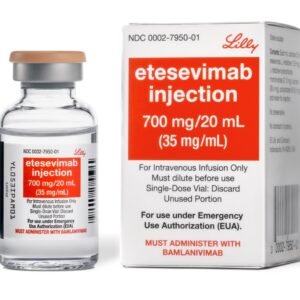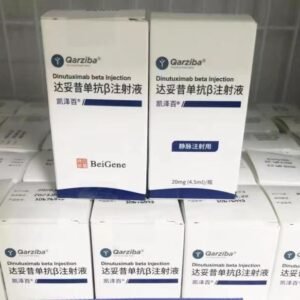Octreotide Acetate Microspheres for Injection
Function and indications:
Proven use: Acromegaly For the treatment of the following patients with acromegaly: patients whose condition has been adequately controlled after subcutaneous injection of standard doses of Sandostatin; patients who are not suitable for surgery, radiotherapy or ineffective treatment, or patients in the potential response stage before radiotherapy can fully achieve its effect. Gastroenteropancreatic endocrine tumors Patients with symptoms associated with functional gastrointestinal pancreatic endocrine tumors have been adequately controlled with subcutaneous Sandostatin. Carcinoid with features of carcinoid syndrome. Vipoma. Glucagonoma. Gastrinoma/Zollinger-Ellison syndrome. Insulinoma (for the prevention and maintenance of preoperative hypoglycemia). Growth hormone releasing factor adenoma.
Usage and Dosage:
This product can only be administered by deep injection into the gluteal muscle and never by intravenous injection. If the blood vessel is penetrated, the injection site should be changed. Repeated injections should be injected into different gluteal muscles on the left or right side in turn. Acromegaly For patients who are fully controlled with standard doses of subcutaneous Sandostatin, the recommended initial dose of this product is 20 mg, administered once every 4 weeks for 3 months. Treatment can be started 1 day after the last subcutaneous injection of Sandostatin. Thereafter, the dose should be determined based on serum GH and growth factor C (IGF-1) concentrations and clinical symptoms and signs. If clinical symptoms and signs and biochemical parameters (GH and IGF-1) are not fully controlled (GH>2.5 ug/L) after 3 months, the dose should be increased to 30 mg, administered once every 4 weeks. If GH≤ (smaller than or equal to) 2.5 ug/L, continue to use 20 mg treatment, administered once every 4 weeks. If after 3 months of treatment with 20 mg, GH concentrations continue to be less than 1 ug/L, IGF-1 concentrations are normal, and clinically reversible symptoms and signs of acromegaly disappear, the dose of this product can be reduced to 10 mg. Given such low doses, serum GH and IGF-1 concentrations as well as clinical symptoms and signs should be closely monitored. For patients who are not suitable for surgery, radiotherapy, dopamine agonist treatment or treatment failure, or patients whose condition is in the latent response stage before radiotherapy can fully take effect, it is recommended to use subcutaneous injection of Sandostatin for a short period of time before starting the above treatment with this product to evaluate the tolerability and efficacy of octreotide treatment. Gastroenteropancreatic endocrine tumors Patients who have been treated with subcutaneous injection of Sandostatin: For patients whose symptoms have been completely controlled by subcutaneous injection of Sandostatin, the recommended initial dose of this product is 20 mg, administered once every 4 weeks. The original effective dose of subcutaneous injection of Sandostatin should be maintained for at least 2 weeks after the first injection of this product (some patients need to maintain it for 3-4 weeks). Patients who have never been treated with subcutaneous injection of Sandostatin: It is recommended that before starting treatment with this product, Sandostatin 0.1 mg should be injected subcutaneously 3 times a day for a short period of time (about 2 weeks) to evaluate the treatment response and systemic tolerance of octreotide. Dose adjustment After 3 months of treatment with this product, for patients whose symptoms and biochemical indicators are completely controlled, the dose of this product should be reduced to 10 mg, administered once every 4 weeks. For patients whose symptoms are only partially controlled after 3 months of treatment with this product, the dose should be increased to 30 mg, administered once every 4 weeks. During the treatment of gastrointestinal and pancreatic tumors with this product, the patient’s symptoms will be more obvious for a period of time. At this time, it is recommended to add subcutaneous injection of Sandostatin, and the dose is the same as before the use of this product. This is particularly important for achieving therapeutic levels of blood octreotide in the first 2 months of treatment. Use in patients with renal impairment: When subcutaneous injection of Sandostatin is used for treatment, renal impairment does not affect the area under the curve (AUC) of blood octreotide. Therefore, the dose of this product does not need to be adjusted. Use in patients with hepatic impairment: Studies of Sandostatin administered by subcutaneous and intravenous routes have found that the clearance of patients with cirrhosis may be reduced, but not patients with fatty liver. Given the wide therapeutic window of octreotide, the dose of this product does not need to be adjusted in patients with cirrhosis.
Adverse reactions:
The most common adverse reactions are local reactions and gastrointestinal symptoms. Local reactions: Local reactions to this product (pain, rare edema and rash) may occur at the injection site. These are usually mild and transient. Gastrointestinal symptoms: Gastrointestinal
Share:
Products
Our offers
Health Classification
Let us work together to protect precious health



























